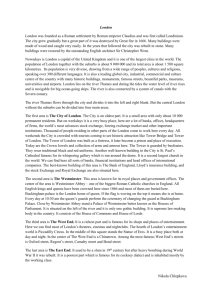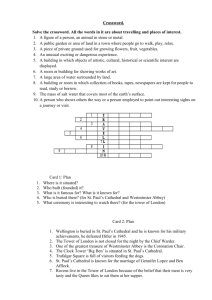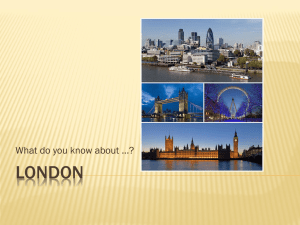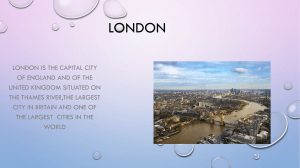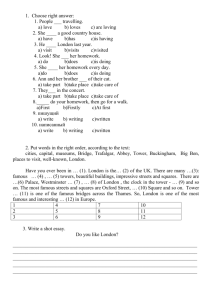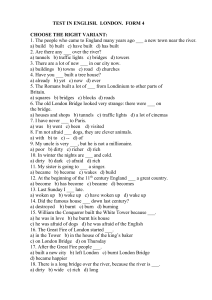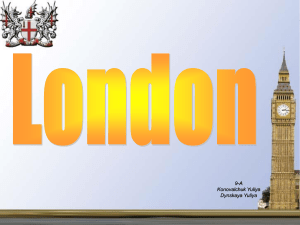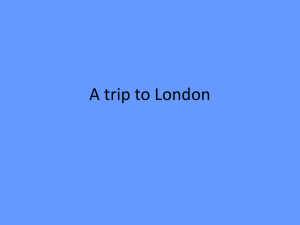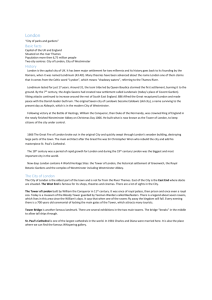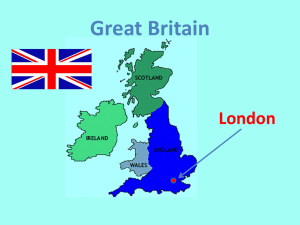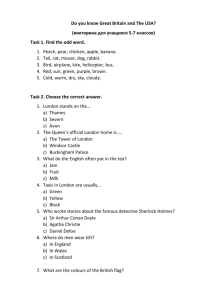The City of London
advertisement
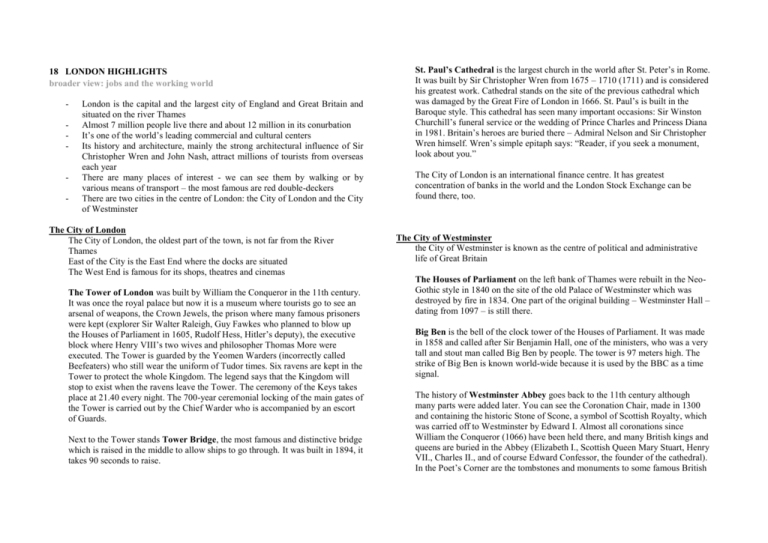
18 LONDON HIGHLIGHTS broader view: jobs and the working world - - London is the capital and the largest city of England and Great Britain and situated on the river Thames Almost 7 million people live there and about 12 million in its conurbation It’s one of the world’s leading commercial and cultural centers Its history and architecture, mainly the strong architectural influence of Sir Christopher Wren and John Nash, attract millions of tourists from overseas each year There are many places of interest - we can see them by walking or by various means of transport – the most famous are red double-deckers There are two cities in the centre of London: the City of London and the City of Westminster The City of London The City of London, the oldest part of the town, is not far from the River Thames East of the City is the East End where the docks are situated The West End is famous for its shops, theatres and cinemas The Tower of London was built by William the Conqueror in the 11th century. It was once the royal palace but now it is a museum where tourists go to see an arsenal of weapons, the Crown Jewels, the prison where many famous prisoners were kept (explorer Sir Walter Raleigh, Guy Fawkes who planned to blow up the Houses of Parliament in 1605, Rudolf Hess, Hitler’s deputy), the executive block where Henry VIII’s two wives and philosopher Thomas More were executed. The Tower is guarded by the Yeomen Warders (incorrectly called Beefeaters) who still wear the uniform of Tudor times. Six ravens are kept in the Tower to protect the whole Kingdom. The legend says that the Kingdom will stop to exist when the ravens leave the Tower. The ceremony of the Keys takes place at 21.40 every night. The 700-year ceremonial locking of the main gates of the Tower is carried out by the Chief Warder who is accompanied by an escort of Guards. Next to the Tower stands Tower Bridge, the most famous and distinctive bridge which is raised in the middle to allow ships to go through. It was built in 1894, it takes 90 seconds to raise. St. Paul’s Cathedral is the largest church in the world after St. Peter’s in Rome. It was built by Sir Christopher Wren from 1675 – 1710 (1711) and is considered his greatest work. Cathedral stands on the site of the previous cathedral which was damaged by the Great Fire of London in 1666. St. Paul’s is built in the Baroque style. This cathedral has seen many important occasions: Sir Winston Churchill’s funeral service or the wedding of Prince Charles and Princess Diana in 1981. Britain’s heroes are buried there – Admiral Nelson and Sir Christopher Wren himself. Wren’s simple epitaph says: “Reader, if you seek a monument, look about you.” The City of London is an international finance centre. It has greatest concentration of banks in the world and the London Stock Exchange can be found there, too. The City of Westminster the City of Westminster is known as the centre of political and administrative life of Great Britain The Houses of Parliament on the left bank of Thames were rebuilt in the NeoGothic style in 1840 on the site of the old Palace of Westminster which was destroyed by fire in 1834. One part of the original building – Westminster Hall – dating from 1097 – is still there. Big Ben is the bell of the clock tower of the Houses of Parliament. It was made in 1858 and called after Sir Benjamin Hall, one of the ministers, who was a very tall and stout man called Big Ben by people. The tower is 97 meters high. The strike of Big Ben is known world-wide because it is used by the BBC as a time signal. The history of Westminster Abbey goes back to the 11th century although many parts were added later. You can see the Coronation Chair, made in 1300 and containing the historic Stone of Scone, a symbol of Scottish Royalty, which was carried off to Westminster by Edward I. Almost all coronations since William the Conqueror (1066) have been held there, and many British kings and queens are buried in the Abbey (Elizabeth I., Scottish Queen Mary Stuart, Henry VII., Charles II., and of course Edward Confessor, the founder of the cathedral). In the Poet’s Corner are the tombstones and monuments to some famous British writers, scholars, dramatists and poets (John Milton, Walter Scott, Lord Byron, William Shakespeare) but only a few of them are really buried there (Geoffrey Chaucer). Buckingham Palace is the London home of the kings and queens of Great Britain. It was built in 1703 but Queen Victoria was the first monarch who lived there – it was in 1837. The Royal family occupies the north wing of the Palace and when Her Majesty is in residence, the Royal Standard is flown from the flagstaff. An inseparable part of the view of Buckingham Palace is the Queen Victoria Monument in front of it. A very popular event is changing of the guard outside Buckingham Palace. Trafalgar Square is a place of political demonstrations and busy traffic. It originated in the 19th century and its name commemorates the naval victory of Admiral Nelson over French and Spanish fleet at Spanish Cape Trafalgar in 1805. In the middle of the square is Nelson’s Column (about 50 m high) with a five – meter tall statue of Horatio Nelson at the top. The Column is surrounded by two fountains and usually lots of pigeons. A short way from Trafalgar Square is Piccadilly Circus. The most beautiful view of the square is at night when it is lit by many colorful advertisements. In the centre of the Circus at the top of the Fountain stands Eros, the Greek God of love. The home of the Prime Minister has been number 10, Downing Street since 1735. St.James’s Park is the oldest of parks in London. It’s one of architect John Nash’s masterpieces. In the 19th century he created a lake with small islands which are the home of many water – birds. Hyde Park is probably the most popular among tourists. It consists of trees and grass intersected by paths, with boating and swimming on the Serpentine lake and horse/riding in Rotten Row. Hyde Park is also known for its Speaker’s Corner, the place where everyone can speak publicly without fear of being arrested for her opinion. Regent’s Park is perhaps London’s most elegant park with its attractive gardens, lakes and a zoo.
